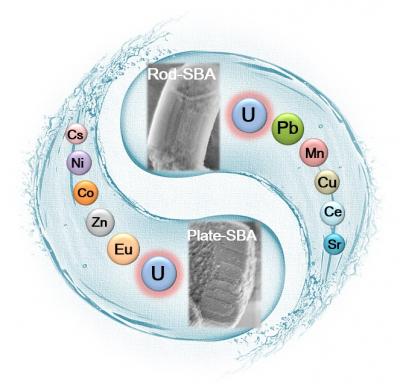
Credit: Author
In a paper to be published in the forthcoming issue in NANO, researchers from China have proposed a way to reduce Uranium concentration in contaminated water. As an essential nuclear fuel, Uranium has been greatly used an inevitably released to the environment. Without proper disposal, exposure to uranium can result in serious harms to the ecology and health of humans.
Mesoporous SBA-15 with ordered mesostructures, high surface areas and large pore sizes have been applied to concentrate U(VI) from aqueous solutions. The exploration of SBA-15 with higher performances also keeps developing. For instance, the synthesis of functional SBA-15 with organic ligands containing N, O, S and P elements, and with controllable morphologies (e.g., rods, plates, and fibers) and tunable mesostructures have also been reported. However, the comprehensive evaluation of structure-composition-function relationships, including the interconnected influence of textural characteristics of sorbents and the interaction mechanism of U(VI)-surface modified chemical groups, has not been fully studied yet.
This paper investigates how the synergistic integration of pore mesochannels and surface functionalization of SBA-15 enables high-performance U(VI) sorption. In this study, we report the rapid sorption of U(VI) with high capacities and selectivity by amidoxime functionalized ordered mesoporous SBA-15 with two typical morphologies (i.e., rods and plates) via a post-grafting method. The results show that the mesostructures including morphologies and pore length of SBA-15 perform the dominant function for the fast sorption kinetics (10 min for plates, 20 min for rods), while the modified amidoxime groups make excellent U(VI) sorption capacities (646.2 mg/g for plates, 499.8 mg/g for rods at pH 5.0 and T 298.15 K) and high selectivity possible. U(VI) adsorbed amidoxime-functionalized SBA-15 can also be effectively regenerated by HCl solutions and reused well after six cycles, exhibiting favorable potentials for the uptake of radionuclides in real environmental management.
###
This work was supported by CAS Pioneer Hundred Talents Program, the CASHIPS Director’s Fund (No. YZJJ2018QN20), the National Natural Science Foundation of China (Nos. 21875257 and 51708215) and Henan Science and Technology Project (No. 152102310343).
Additional co-authors of this work in the journal NANO are Ziyan Yang and Xiaoli Yang form North China University of Water Resources and Electric Power, Junfeng Wu from Henan University of Urban Construction.
Corresponding author for this study is Rui Hu, [email protected].
For more insight into the research described, readers are invited to access the paper on NANO.
IMAGE
Caption: A schematic illustration of the efficient sorption of uranium from aqueous solutions by mesoporous silica SBA-15 with various morphologies. The mesostructures including morphologies and pore length of SBA-15 perform the dominant function for the fast sorption kinetics, while the modified amidoxime groups make the excellent U(VI) sorption capacities and high selectivity possible.
NANO is an international peer-reviewed monthly journal for nanoscience and nanotechnology that presents forefront fundamental research and new emerging topics. It features timely scientific reports of new results and technical breakthroughs and publishes interesting review articles about recent hot issues.
About World Scientific Publishing Co.
World Scientific Publishing is a leading independent publisher of books and journals for the scholarly, research, professional and educational communities. The company publishes about 600 books annually and about 135 journals in various fields. World Scientific collaborates with prestigious organizations like the Nobel Foundation and US National Academies Press to bring high quality academic and professional content to researchers and academics worldwide. To find out more about World Scientific, please visit http://www.
For more information, contact Tay Yu Shan at [email protected].
Media Contact
Tay Yu Shan
[email protected]
Original Source
https:/
Related Journal Article
http://dx.




